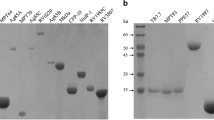Abstract
McGlynn and her co-workers have reported that among the Vietnamese refugees in Philadelphia and among Alaskan natives who are hepatitis B carriers, there is a statistically significant association between anegative tuberculin test and the presence of hepatitis B e antigen. A repetition of this work among the population of Bangalore did not yield any significant results because of the very low incidence of hepatitis found among this population. However, on the basis of available data that hepatitis B infection is more prevalent among the Mongolian population than among people of other populations, the work was repeated among Tibetans who had settled down in Karnataka. This set of experiments showed that, contrary to the report of McGlynnet al, there is a statistically significant association between apositive tuberculin test and the presence of hepatitis B e antigen and that those individuals who showed the presence of hepatitis B e antigen exhibited less severe form of the disease than those who were negative to this antigen. These findings suggested that immunity to tuberculosis and hepatitis B infections may have a common underlying principle. Data bank search revealed a stretch of amino acid sequences which is common to hepatitis B e antigen and 19 kDa antigen ofMycobacterium tuberculosis. The significance of these results is discussed.
Similar content being viewed by others
References
Ashbridge K R, Booth R S, Watson J D and Lathigra R B 1989 Nucleotide sequence of the 19 kDa gene fromMycobacterium tuberculosis;Nucleic Acids Res. 17 1249
Berkeley J S and Berkeley I K 1970 Preliminary report on leprosy in Bhutan;Int..1. Lepr. 38 78–82
Blinkowa A L and Walker J R 1990 Programmed ribosomal frameshifting generates theEscherichia coil DNA polymerase III Τ subunit from within the Τ subunit reading frame;Nucleic Acids Res. 18 1725–1729
Cochrane R G 1947 Epidemiology; inPractical textbook of leprosy (Oxford: Oxford University Press) pp 13–16
Collins M E, Patki A, Wall S, Nolan A, Goodger J, Woodward M J and Dale J W 1990 Cloning and characterisation of the gene for the 19 kDa antigen ofMycobacterium bovis;J. Gen. Microbial. 136 1429–1436
Galibert F, Mandart E, Fitoussi F, Tiollais P and Charnay P 1979 Nucleotide sequence of the hepatitis B virus genome (subtype ayw) cloned inE. coli;Nature (London) 281 646–650
Gudat F, Bianchi L, Sonnabend W, Thiel G, Aenishaenshin W and Stalder G A 1975 Pattern of core and surface expression in liver tissue reflects state of specific immune response in hepatitis B;Lab. Invest. 32 1–9
Job C K 1965 An outline of the pathology of leprosy;Int. J. Lepr. 33 533–541
Landschulz W H, Johnson P F and McKnight S L 1988 The leucine zipper: a hypothetical structure common to a new class of DNA binding proteins;Scienc,240 1759–1764
Liang T J, Hasegawa K, Rimon N, Wands J R and Ben-Porath E 1991 A hepatitis B virus mutant associated with fulminant hepatitis;N. Engl. J. Med. 324 1705–1709
MacKay P, Lees J and Murray K 1981 The conversion of hepatitis B core antigen synthesized inE. coli into e antigen;J. Med. Virol. 8 237–243
Maizel J. V and Lenk R P 1981 Enhanced graphic matrix analysis of nucleic acid and protein sequences;Proc. Natl. Acad. Sci. USA 78 7655–7669
McGlynn K A, Lustbader E D and London W T 1985 immune responses to hepatitis B virus and tuberculosis infections in Southeast Asian refugees;Am. J. Epidemiol. 122 1032–1036
McGlynn K A, Lustbader E D, London W T, Heyward W L and McMahon B J 1987 Hepatitis B virus replication and tuberculin reactivity: Studies in Alaska;Am. J. Epidemiol. 126 38–43
Omata M, Ehata T, Yokosuka O, Hasoda K and Ohto M 1991 Mutations in the precore region of hepatitis B virus DNA in patients with fulminant and severe hepatitis;N. Engl. J. Med. 324 1690 1704
Sherker A H and Marion P L 1991 Hepadnaviruses and hepatocellular carcinoma;Anna. Rev. Microbtol 45 475–508
Stahl S, MacKay P, Magazin M, Bruce S A and Murray K 1982 Hepatitis B virus core antigen, its synthesis inE. coli and application in diagnosis;Proc. Natl. Acad. Sci. USA 79 1606–1610
Suzuki N, Choe H, Nisida Y, Yamawaki-Katoka Y, Ohnishi S, Tamaoki T and Kataoka T 1090 Leucine-rich repeats and carboxyl termini are required for interaction of yeast adenylate cyclase with RAS proteins;Proc. Natl. Acad. Sci. USA 87 8711 8715
Tiollais P, Pourel C and Dejean A 1985 The hepatitis B virus;Nature (London) 317 487–505
Wrolewski F and La Due J 1956 Serum glutamic pyruvic transaminase in cardiac and hepatic disease.Proc. Soc. Exp. Biol. Med. 91 569–571
Author information
Authors and Affiliations
Rights and permissions
About this article
Cite this article
Apte, M., Shamala, N. & Ramakrishnan, T. Antigenic relationship between reactivity to hepatitis B e antigen and 19 kDa protein ofMycobacterium tuberculosis among the Tibetan settlers in Karnataka. J Biosci 17, 305–312 (1992). https://doi.org/10.1007/BF02703156
Received:
Revised:
Issue Date:
DOI: https://doi.org/10.1007/BF02703156




